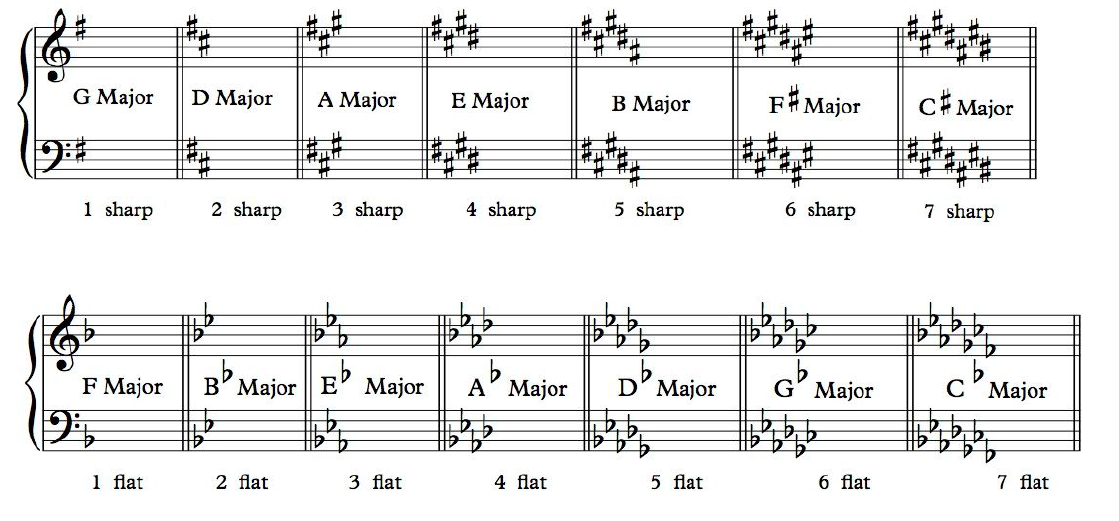
In the Key of...
“In the key of…” -- we rarely get far into our musical endeavors before we find ourselves faced with this phrase. Minuets in the key of G, Sonatas in the key of A, Nocturnes in the key of E minor, Fugues in the key of F#, and so on. But what does it really mean to be "in the key" of something?
As beginners, we learn that it in some way refers to the number of sharps or flats (accidentals) we encounter at the beginning of a piece. We learn that this key signature indicates which notes will be sharped or flatted throughout the piece until its end, or until we encounter another key signature.
Many teachers refrain from teaching much further into the topic of keys until students are more experienced and more easily able to digest the theory and technicalities. Even then, many students have achieved a fair amount of competence on their instrument working under the simple impression that more accidentals in the key signature means a more complicated key. Most deeper studies of keys typically fall within the precincts of college study.
Why is this? Why are keys one of the most used but least-well comprehended of musical devices amongst beginning and intermediate learners?
As with many of music’s more dynamic technical or theoretical ways of thinking, the answer is far less about the ‘what’ than about the ‘how.’ How are keys used? How do we understand them more easily? How can they help us in the study of the music we’d like to learn?
The truth is that an understanding of keys is a deeply valuable tool for learning music. Keys themselves are derived from what many consider to be a very natural inclination within our musical minds to perceive structure and the resolution of dissonance in music. To be sure, there are many kinds of music that do not rely on keys as the basis for their compositional design, however as students of Western Classical, Jazz, and Pop music, we will constantly encounter music constructed using keys.
So how do we learn?
In this article series we will establish a clear and working groundwork for what keys are and what they can do for you. Along the way, you will gain a richer understanding of the more basic musical devices we will use to create that groundwork.
So, what are those basic musical devices you ask?
Instead of expending any more time on written explanation, let’s do what we should be doing as musicians, let’s look at some music!
Our Friendly Master Mozart
Below is an excerpt from the beginning of a Mozart piece you may be familiar with, Sonata No. 16 in C-Major, K. 545. See if you can recognize it without listening to it or sight-reading it on your instrument. If you're a beginner, this might look a little intimidating. Look at all those 16th notes…
Give it a listen here. By the way, the name of that little girl playing is Yuja Wang, and if you’ve not heard of her you should definitely type her name into your browser sometime.
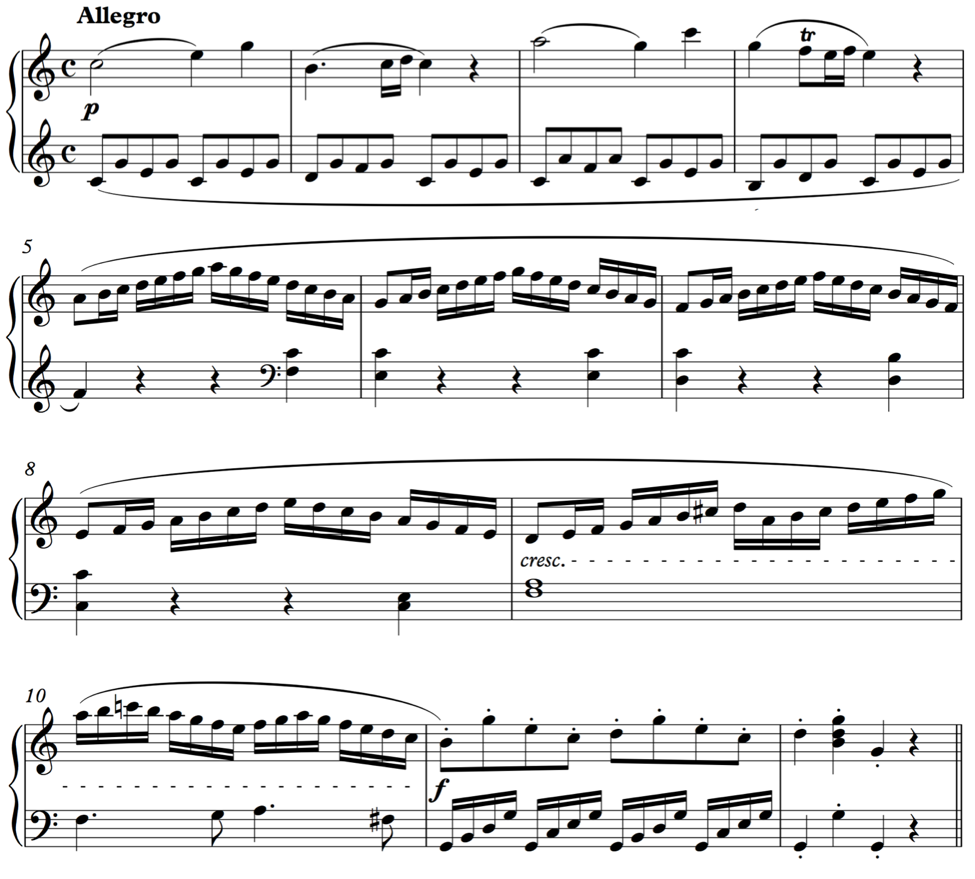
Despite its fame and association with the piano recitals of younger learners (Mozart himself even considered it a ‘beginners’ sonata), this piece is not without its challenges, and it falls solidly into the realm of intermediate literature for most students.
It also provides us with very clear examples of some of the devices we might use to better understand keys.
Let’s take another look at this opening to get a glimpse of what someone with an understanding of keys might see….

Notice that we now have several visual additions. Be aware, these amendments are not meant to be taken as literal (asking a pianist about the colors of a particular passage of music will probably get them talking about something other than what you're seeing above), but as representations of the particular kinds of information someone with an experienced knowledge of keys will probably consider when studying or playing a piece.
Throughout the entirety of this article series, we will use color coding such as that seen above to help us more easily visualize important points and figures.
In this short passage, through color coordination, we can see the important devices for deciphering and visually perceiving keys. (Don’t worry if some or all of these things are unfamiliar to you; we will introduce and explain them over the course of this article series.) These colors highlight ways that advanced musicians might see and hear keys when looking at a piece of music. First and foremost, notice the key signature, which is circled by the red oval. Note that it has no sharps or flats, which indicates we're in the key of C major. The blue, green, and orange margins indicate areas of harmonic importance, specifically as they relate to thinking about the key we’re in. Blue represents the tonic area (I), the most harmonically stable area. Green and orange represent the dominant (V) and pre-dominant (IV) areas, which pull us away from tonic (I) momentarily to create some harmonic instability. Eventually, we resolve back to our tonic (I), the blue. Finally, the pink and purple margins show us some clear examples of the scale of the key being used musically in a way that retains its recognizable form, even though at first glance it seems that each measure uses a different scale.
With all music, the ease with which we can take take all of the bits and pieces and make them seem bigger or less complicated is directly related to how efficiently it can be learned.
Summing it Up
Whew. That’s quite a lot of information packed into twelve colorful bars, yes? Let’s sum it up into a sentence that illustrates things more simply:
A musician with a knowledge of chords, scales, and the ways in which they relate to the key signature is much more easily able to think of music in terms of keys.
Great. But that still doesn’t quite answer why learning all this for the sake of knowing about keys is worthwhile. The summary sentence for that is where things really get interesting. It looks something like this:
A musician with a knowledge of keys is much more easily able to identify chords, scales, their relationships with one another, and their relationship with the piece as a whole.
So wait…we need to learn about chords and scales to apply to the study of keys but knowing about keys tells us about the chords and scales they consist of?
Many musical concepts are learned most effectively via a combination of drilling and contextual importance. In other words, we tend to learn best by practicing a lot and by really understanding why we’re practicing. Most of what makes up music consists of small variations on similar ideas and musical devices. The notes, chords, scales, and other identifying musical features of any piece are really just different combinations of similar core material, and part of our goal as musicians is to compile as much of this info as we can for use in playing.
Thus: understanding and thinking in keys gives us the ability to structure a whole world of musical devices and relationships under the umbrella of a single idea.
To help us achieve that understanding, it is important to make the most of the examples provided in this article and the rest of the articles in this series. As such, you should be playing through each example at the keyboard, or (where relevant) listening to the examples provided.
Let’s look at a few more musical examples to help support this umbrella-idea of keys.
Take a look at the simple melody notated below. The words here are solfeggio, which can be helpful if you’re familiar with them, but are otherwise unnecessary for what we're discussing, so if you’re not familiar with them, feel free to use a single syllable such as ‘la’ or ‘lu.’

Go ahead and sing it aloud (it’s ok to play it at the piano, but try to memorize it so that you can sing it by yourself).
Recognize it?
Now, see if you can sing it starting at a higher or lower pitch. Try to not do this with any instrument other than your voice, try to hear and sing the melody higher or lower as you might something you’d sing in the car or hum in the shower.
Did you do it? See if you can do it again at a different pitch. Once again, don’t think too hard about the notes, simply try to hear and sing the melody once you’ve got the higher or lower pitch.
Each time you do this you’re accomplishing a musical technique known as transposition, which is when we take a musical structure and relocate it to higher or lower pitches without changing it in any other way.
On a very simplified level, you’re changing the key each time you do this.
The takeaway point here is that you were able to do this simply by internalizing the melody and letting your musical mind take it higher or lower. If you were to take this exercise to the piano, you would find that a good deal of thinking might be involved to consider the accidentals (the black notes) that need to be used to accomplish the same task. You’d be back to thinking about the smallest pieces of the picture. For experienced and skilled pianists, the process of transposing at the piano is as easy a task as it was for you to sing this melody in different places without too much thought--a knowledge of keys is how this is possible.
Taking the Long View
Let’s look at one more thing. Now that we’ve seen something of an intuitive example for how we might benefit from thinking in keys, let’s take a look at something more regimented:
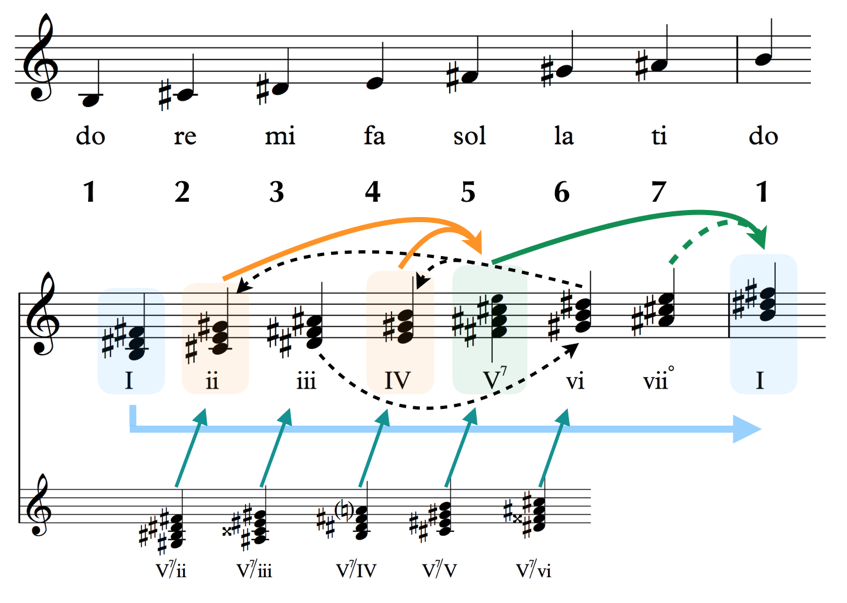
Don’t worry, the excerpt above is only here to represent the greater world of musical information that exists, and to help make a point. What we’re looking at are visual examples of some of the significant relationships and bits of information that a key-literate musician will likely think of when they see a particular key signature. With a knowledge of keys, all of the above information can be distilled down to this:
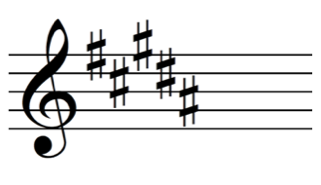
Compared to the previous excerpt, the five sharps in this key-signature don’t look nearly so bad do they?
Even this is not completely representative of the full potential of key-based thinking, and most of it lies far beyond what we will accomplish in this article series.
Our goal will be to establish a core understanding of keys, rather than to go through all the nitty-gritty details. We want to understand how a knowledge of keys can make our music-learning easier, and how we do it without having to slog through years of college music theory.
As is the case with any musical training, the most important ally you have is a strong familiarity with the fundamentals of musical structure and expression.
Over the next several articles, we will build upon that fundamental knowledge to put towards a simple but comprehensive understanding of what in means to be “in the key of” something. We will reintroduce and reinforce our knowledge of chords and scales to help us, and we will go about learning as much as we can using examples from real music to show how these concepts are actually applied.
To accomplish all of this, we will present six articles that break down keys into a number of components, starting with some basic fundamentals, and then moving onto looking at how we can apply those fundamentals to our understanding of keys. The articles are linked in order below:
- What are Keys?: Learning about Scales: A basic introduction and reinforcement of scale theory as a basis for our understanding of keys.
- What are Keys?: Learning about Chords: A basic introduction and reinforcement of chord construction and harmonic theory as a further basis for our understanding of keys.
- Discovering Keys: Part I: Here we apply our knowledge of scales and chords directly to understanding the structure of keys.
- Discovering Keys: Part II: In this article we continue our application of scale and chord theory to the study of keys, looking closer at how to understand keys contextually.
- Discovering Keys: Minor Keys: A special article that focusses on minor keys and the more complicated structure and use of the minor scale.
- Discovering Keys: From Then to Now: In our concluding article, we take our understanding of keys into the real world, investigating how they are used in different types of musical settings.
Consider this article series the vista view of keys. Our musical journeys will be long and full of enriching travels, so any chance we can get to survey the landscape before we dive into it should be taken. In these articles, we will survey the landscape of learning about keys so we are more prepared to walk down those paths and benefit from what they have to show us.
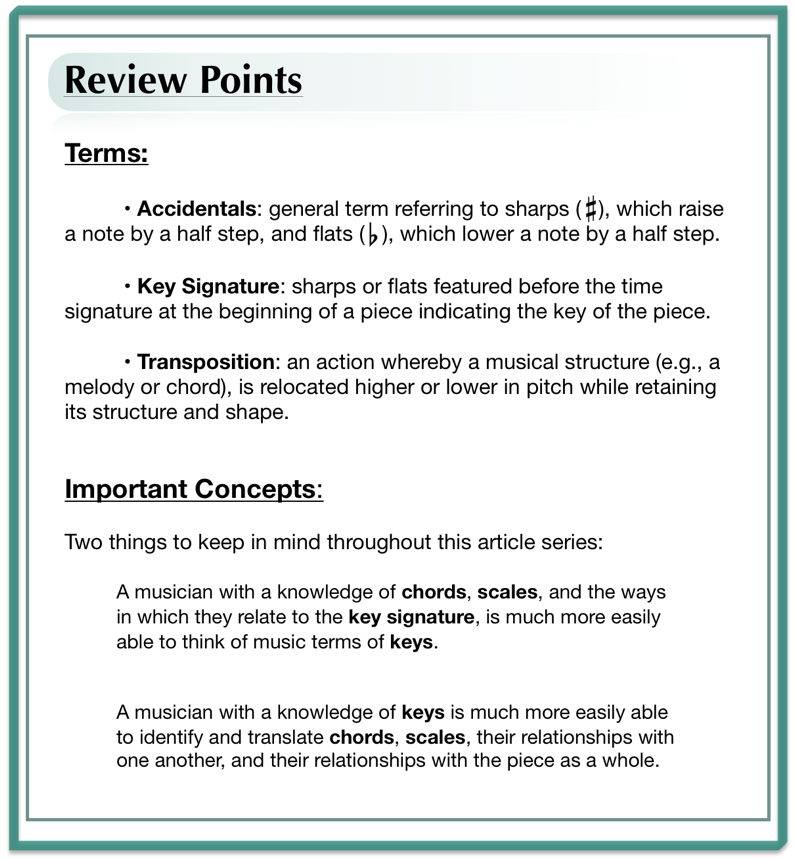



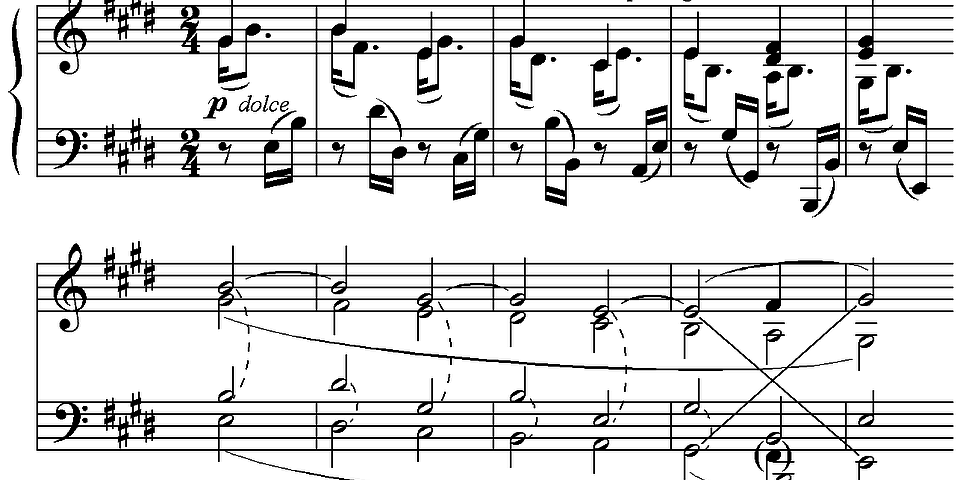

Extremely well-written. Thanks, West.